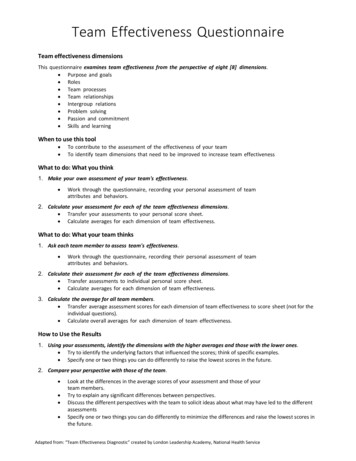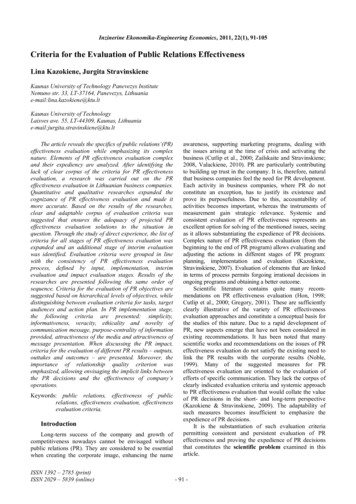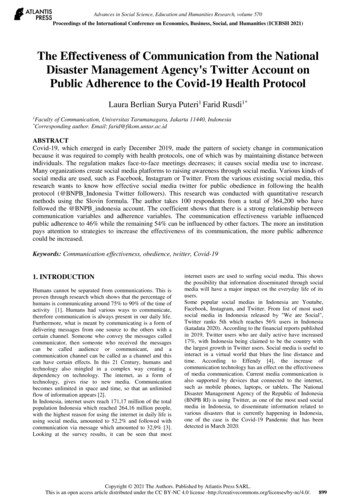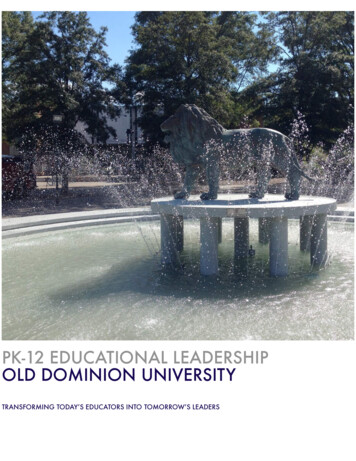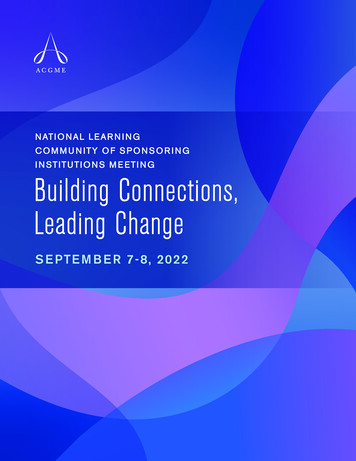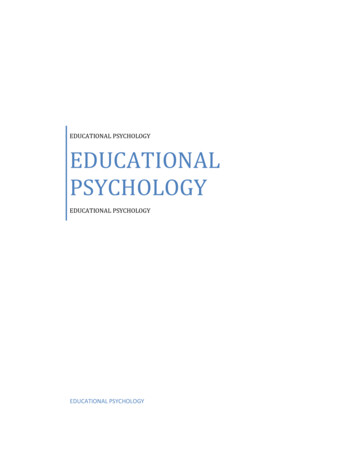
Transcription
U . S .C O M M I S S I O NO NC I V I LR I G H T SThe Educational Effectiveness ofHistorically Black Colleges and UniversitiesBR I E F I NGREPORTU. S . C O M M I S S I O N O N C I V I L R I G H T SWashington, DC 20425Visit us on the Web: www.usccr.govNOVEMBER 2010
The EducationalEffectivenessof Historically BlackCollegesand UniversitiesA Briefing BeforeThe United States Commission on Civil RightsHeld in Washington, D.C.Briefing Report
The Educational Effectiveness of Historically Black Colleges and Universities i
Table of ContentsiTABLE OF CONTENTSEXECUTIVE SUMMARY .1FINDINGS AND RECOMMENDATIONS .8INTRODUCTION.11SUMMARY OF THE PROCEEDINGS .17Louis W. Sullivan .17Historically Black Colleges and Universities and the Development ofStudents.17The Morehouse School of Medicine.17Factors Accounting for the Educational Success of Students atHistorically Black Colleges and Universities .18Earl S. Richardson .18Challenging the Rightful Place of Historically Black Colleges andUniversities in Higher Education.18Impact of the Civil Rights Act of 1964 on Historically Black Collegesand Universities .19How the Historically Black Colleges and Universities Survived .20Historically Black Colleges and Universities are Primary in Narrowingthe Higher Educational Gap between African-Americans andWhites .20Jamie P. Merisotis.22Four Areas of HBCU Effectiveness.22Serving as Leaders in Student Engagement.22Promoting Civic Engagement and Service Learning.23Enabling Educational Attainment for Low Income, First Generation,and Disabled Students.23Science, Technology, Engineering, and Mathematics (STEM).24Raymond C. Pierce .24A Real and Continuing Threat to Historically Black Colleges andUniversities .24Desegregation in Higher Education .25The 1978 Civil Rights Policy for Higher Education Desegregation.26The 1994 Federal Policy for Higher Education Desegregation .26The Present.27Mikyong Minsun Kim.28Four Areas of Focus.28Institutional and Student Characteristics of Historically Black Collegesand Universities and Historically White Colleges and
iiTable of ContentsUniversities .28Research Findings on Selected Outcomes .30Historically Black Colleges and Universities and Student Engagementand Development .31Historically Black Colleges and Universities Merit Support.32Discussion Summary .32Academic Outcomes at Historically Black Colleges and Universities .32Dropout, Graduation, and Performance on National Examinations .33Historically Black Colleges and Universities as Pipeline to GraduateSchool .34Historically Black Colleges and Universities, STEM, and TeacherEducation Programs .34Historically Black Colleges and Universities as Catalyst for Change .35A Nurturing Environment .36Lack of Parity between HBCUs and Non-HBCUs .37Subsidizing Student Tuition.37Greater Staff Workload.38Lack of Adequate Facilities .38Lack of Technology Transfer and Commercialization Centers.38Faculty Salaries.39The Right to Exist .39Struggle Over State Funding and Program Duplication .40A Complementary System of Higher Education .42Dearth of Black Male Undergraduates at TWIs .44Policy Initiatives to Support HBCUs.44Threats that Imperil HBCUs .45STATEMENTS .47Louis W. Sullivan, M.D., Chair of The President’s Board of Advisors onHistorically Black Colleges and Universities .47Contributions of Historically Black Colleges and Universities to theNation.47Earl S. Richardson, President, Morgan State University .49Jamie P. Merisotis, President, Institute for Higher Education Policy.54HBCUs and Student Engagement.56HBCUs and Civic Engagement/Service-Learning.56HBCUs and Success for Low-Income, First Generation, and DisabledStudents.57HBCUs and Science, Technology, Engineering and Math (STEM) .58Raymond C. Pierce, Dean and Professor of Law, North Carolina CentralUniversity.61Failure of the Federal Government to Enforce Federal Civil RightsLaws: A Real Threat to Historically Black Colleges andUniversities .61Mikyong Minsun Kim, Associate Professor of Higher Education, GraduateSchool of Education and Human Development, The George
Table of ContentsiiiWashington University .65Institutional and Student Characteristics at HBCUs versus HWCUs .65Effectiveness of HBCUs versus HWCUs .66Academic Development and Success .66Early Career Earnings .66How Do Students’ Learning Opportunities Differ between HBCUs andHWCUs? .67Conclusion and Recommendation .67The Role of Ethnicity in Choosing and Leaving Science in Highly SelectedInstitutions.78The Causes and Consequences of Attending Historically Black Colleges andUniversities .102SPEAKER BIOGRAPHIES .150COMMISSIONER STATEMENTS.155Statement of Commissioner Abigail Thernstrom .155Dissent of Commissioners Michael Yaki and Arlan D. Melendez.157Rebuttal By Commissioner Gail Heriot.158
Executive Summary1EXECUTIVE SUMMARYThe Black College and University Act defined an historically black college and university(HBCU)1 as one that existed before 1964 with a historic and contemporary mission ofeducating blacks while being open to all. An HBCU must either have earned accreditationfrom a nationally recognized accrediting agency or association or be making reasonableprogress toward accreditation. Currently, 103 HBCUs are located mainly in the SoutheasternUnited States, the District of Columbia, and the Virgin Islands.The U.S. Commission on Civil Rights conducted a briefing on May 5, 2006, to assess theeducational effectiveness of HBCUs. The Commission invited five distinguished panelists todiscuss the issue: Louis W. Sullivan, founding dean and first president of Morehouse Schoolof Medicine, as well as a presidential advisor and former cabinet secretary; Earl S.Richardson, president of Morgan State University and a former presidential advisor onHistorically Black Colleges and Universities; Jamie P. Merisotis, president of the Institute forHigher Education Policy; Raymond C. Pierce, dean and professor of law at North CarolinaCentral University and a former deputy assistant secretary at the U.S. Department ofEducation; and Mikyong Minsun Kim, associate professor at the George WashingtonUniversity’s Graduate School of Education and Human Development.After the briefing, Commissioners offered two articles to help provide the reader with aricher understanding of the subject because policymakers should base conclusions about theefficacy of HBCUs in educating black students as compared to non-HBCUs on strongerevidence than mere public support. In both studies the researchers rely on extensive empiricaldata to reach their conclusions. The two articles are reproduced at the end of this report andcast some additional light on the briefing topic.In one study,2 economists Fryer and Greenstone found that during the 1970s, HBCUattendance resulted in a greater likelihood of graduation when compared to black attendees attraditionally white institutions, as well as an increased probability of majoring in a physicalscience. As important, HBCUs provided a substantial wage premium to their graduates.However, by the 1990s, HBCU attendance yielded a substantial wage penalty to blackmatriculants in comparison with black students attending a traditionally white institution.1During the course of this briefing our panelists and commissioners used a wide variety of terms to describe acollege or university that is not an HBCU. These terms included traditionally white institutions, historicallywhite colleges and universities, and predominantly white schools, among others. For clarity in this report weused the term non-HBCU except when directly referencing a phrase, sentence or quotation from the preparedstatements or the transcript where the panelist or author used a different but synonymous term. In these caseswe used the term or phrase used by the panelist or author.Terms such as traditionally white institutions and historically white colleges and universities shouldnot be construed to mean that such institutions are racially segregated or that blacks or other minorities arediscouraged from attending those institutions. In fact, many institutions which our panelists describe usingterms such as historically white college or university are quite racially diverse.2Roland G. Fryer, Jr., and Michael Greenstone, “The Causes and Consequences of Attending Historically BlackColleges and Universities,” National Bureau of Economic Research Working Paper No. 13036, April 2007.
2The Educational Effectiveness of Historically Black Colleges and UniversitiesOther differences are more positive. Students attending HBCUs appear to demonstrateincreased charitable giving, political participation, religious participation, and propensity tomajor in the physical sciences compared with those who went to traditionally whiteinstitutions.In the second research effort Commissioners identified, psychologists Elliott, et al.,3 soughtto assess the effects of black students attending HBCUs rather than non-HBCUs. The studyfocused on predictors of whether or not black students decide to major in the sciences withsome discussion of the special role HBCUs might play in this process. The authors note aninitial substantial interest in, and favorable feelings toward, science among blacks pursingscience careers, an effect more positive than that found among white students. The blackstudents failed to manifest such interest later in college and subsequently. To understand thischange, the researchers studied the likelihood of students enrolled in four Ivy Leagueinstitutions majoring in science and, to a lesser extent, of their dropping out of collegecompletely. Elliott, et al., were particularly interested in the situation of high-ability minoritystudents.The researchers’ overall finding is that “preadmission variables accounted for a significantfraction of the variance in persistence decisions, while ethnicity did not.” Although blackstudents have a greater initial interest in choosing science majors and careers than whites,and an attraction equal to that of all nonblacks, the heightened appeal of these pursuits is notsustained. While students’ initial interest predicts their persistence in the field of science, theenhanced attraction does not stem the disproportionately large attrition among black students.The analysis indicates that the greater attrition of black majors arises from a very largedisadvantage in black students’ average developed academic ability compared to whites andAsian Americans.Elliott, et al., indicate that the relative position of blacks in HBCUs as compared to those atnon- HBCUs probably accounts for the positive effects of HBCUs. The authors note thatblack students at non-HBCUs—even those who score well compared to national racial andethnic norms—are competitively disadvantaged relative to their school’s student body onindicators of developed ability that predict science persistence and achievement, particularlyat elite colleges and universities. This results in weaker performance and persistence amongblacks than might occur in less competitive settings. The authors note that the differences arelarge enough to suggest that the achievement gaps are due to nonacademic factors as well asto differences in developed ability.Most importantly in the context of this briefing, Elliott, et al., note that while HBCUenrollees and graduates have quite low SAT scores and high school grades, they nonethelessproduce 40 percent of black engineers with only 20 percent of black enrollment. They alsonote that the top 21 undergraduate producers of blacks with doctoral degrees were HBCUs,and none of the highly successful schools were among the 30 most selective academicinstitutions.3Rogers Elliott, A. Christopher Strenta, Russell Adair, Michael Matier, and Jannah Scott, “The Role ofEthnicity in Choosing and Leaving Science in Highly Selective Institutions, ” Research in Higher Education,vol. 37, No. 6. (1996).
Executive Summary3Elliott, et al., found support for their comparative performance hypothesis in a re-analysis ofdata from 11 private colleges. The research shows that, when students are ranked by SATmath scores and divided into three groups, each institution awarded science degrees to, onaverage, 54 percent of students in the top tercile, 31 percent in the middle group, and only 15percent in the bottom third, regardless of differences across colleges in each tier’s averagemath scores. While having a higher SAT math score is associated with becoming a sciencegraduate, the rank of an SAT math score within any given institution also matters inpredicting whether a student will become a science graduate. For example, a student amongthe top third of a less selective institution is likely to have a far greater probability ofgraduating with a science degree than a student in the bottom tercile of a selective institution,even when they have the same SAT math score. The example that Elliott and his coauthorsprovide predicts that 55 percent of the former, and only 15.4 percent of the latter, are likely tograduate with a science degree. Relative student position in institutions matters. Here, then,the HBCUs can continue to have an important role in nurturing academic talent among blackstudents.Despite widely ranging methods, data sources, and professional disciplines, theories, andanalyses, both studies that Commissioners contributed to the record after the briefing supportthe conclusion that HBCUs make a distinctive contribution to the well-being of blackAmericans.In the briefing session, Dr. Sullivan stated that for some young African-Americans thedevelopment that occurs at HBCUs might have a profound influence on their lives. Forexample, African-American graduates of certain HBCUs, such as Xavier University, SpelmanCollege, and Morehouse College, successfully gained entry into graduate, medical, engineering,law schools and other fields, in percentages and numbers equaling or exceeding those ofAfrican-American students that attended wealthier, longer established, and predominantly-whiteinstitutions. He noted that graduates of the Morehouse School of Medicine pass nationalmedical examinations at rates equaling or surpassing the overall national pass rate even thoughthe institution is one of the most recently established medical schools in the United States. Dr.Sullivan suggested that faculty members’ dedication to teaching, a supportive socialenvironment on campus, faculty and staff members’ encouragement of students to exploreleadership roles in their chosen careers, and the general availability of faculty role models helpexplain HBCU success.Dr. Richardson indicated that after the enactment of the Civil Rights Act of 1964 (CRA) andinitial federal enforcement in the early 1970s, questions arose about the future role ofHBCUs in contemporary higher education. Previously, there was a clear understanding thatHBCUs were open to all students and were the only type of institution in the Southern statesavailable to African-American students seeking a college education. Continuing, he explainedthat the CRA mandated that non-HBCUs increase minority enrollment but did not requireHBCUs to raise their white enrollment. He went on to say that African-American educationalattainment seriously lagged behind that of whites despite HBCUs’ success in enablingaccess, and that the gap between the two groups has been widening in recent years. Heobserved that HBCUs are far more productive in graduating African-Americans than areselective institutions and therefore must be an “integral part of any strategy for increasing the
4The Educational Effectiveness of Historically Black Colleges and Universitiesnumber of black graduates in the nation.” Elliott, et al., made a comparable point on HBCUproductivity, albeit pertaining to the graduation of science graduates.4Mr. Merisotis said that a 2004–2005 national survey of student engagement found that,compared to African-American students enrolled in “predominantly white institutions,” thoseattending HBCUs reported more interactions with faculty members. He indicated that the2004 Campus Compact5 membership survey documented that HBCUs are more likely to requireservice and service-learning as a condition of graduation. Mr. Merisotis also said HBCUsprovide “additional support, guidance, and mentoring to students from educationally andeconomically disadvantaged backgrounds and disabled students to ensure their admission intoand graduation from college. Finally, he drew attention to the success of the undergraduate-level“HBCU UP” program that the National Science Foundation (NSF) funds at 14 HBCU sites.NSF, he said, reported that at HBCUs in which the program has been in place for five years, thepassing rates in required mathematics courses improved as did performance in mandatoryscience, technology, and engineering courses. Of the science, technology, engineering, andmathematics (STEM) graduates from these HBCUs, he said about 25 percent have acquiredundergraduate research experience that would be helpful to them in graduate school. It bearsnoting that existing empirical literature suggested that blacks aspire to be in science.6 Elliott, etal., pointed out that “intention to concentrate in science is by far the strongest predictor ofactually doing so.”7Dean Pierce stated that HBCUs continue to educate large numbers of African-Americanseffectively, thus contributing to the nation’s need for a learned population and skilledworkforce. He indicated that desegregation efforts in state higher education systems involvedprivate lawsuits seeking equal funding for HBCUs relative to traditionally white institutions inconjunction with federal government intervention. The 1970s Adams cases are illustrative.8 Inthese cases, Dean Pierce said private individuals filed suit in federal court against the Secretaryof the U. S. Department for Health, Education, and Welfare (HEW), the agency itself, and itsOffice for Civil Rights (OCR) for failure to enforce federal civil rights laws with regard to4Rogers Elliott, A. Christopher Strenta, Russell Adair, Michael Matier, and Jannah Scott (1996), “The Role ofEthnicity in Choosing and Leaving Science in Highly Selective Institutions,” Research in Higher Education,Vol. 37, No. 6, p. 684, citing E. Culotta (1992), “Black colleges cultivate scientists,” Science 258: 1216–1218and D. H. Thurgood and J. E. Clark (1995), Summary Report 1993: Doctorate Recipients from United StatesUniversities. Washington, DC: The National Academy Press.5“The National Campus Compact is a coalition of more than 950 institutions committed to the civic purposes ofhigher education.” USCCR briefing transcript, May 5, 2006, p. 27.6Rogers Elliott, A. Christopher Strenta, Russell Adair, Michael Matier, and Jannah Scott (1996), “The Role ofEthnicity in Choosing and Leaving Science in Highly Selective Institutions,” Research in Higher Education,Vol. 37, No. 6, p. 690, citing G. H. Dunteman, J. Wisenbaker, and M. E. Taylor (1979), Race and SexDifferences in College Science Program Participation. Research Triangle Park, N.C.: Research TriangleInstitute and J. Oakes (1990), “Opportunities, Achievement, and Choice: Women and Minority Students inScience and Mathematics,” Review of Research in Higher Education 16:153–222.7Rogers Elliott, A. Christopher Strenta, Russell Adair, Michael Matier, and Jannah Scott (1996), “The Role ofEthnicity in Choosing and Leaving Science in Highly Selective Institutions,” Research in Higher Education,Vol. 37, No. 6, p.690.8Adams v. Richardson, 351F. Supp. 636 (1972) and Adams v. Califano, 430 F. Supp. 118 (D.D.C. 1977).
Executive Summary5African-Americans enrolled in HBCUs. The court found against OCR and directed it to developguidelines to desegregate state systems of higher education. OCR’s 1978 policy, he explained,examined two components to determine civil rights compliance—HBCU enhancement andtraditionally white institution affirmative action in recruitment to attract and enroll moreAfrican-American students. Following Ayers v. Fordice, 1992 (Fordice), he said OCR created apolicy for higher education desegregation in 1994 that was far more rigorous than that of the1978 one. Continuing, he offered that the “problem we face today is almost a re-visitation of thesituation that led to the Adams cases in the 1970s.” In 2000, 2001, and especially 2002, heobserved that some states were seeking to revert to a policy of hindering HBCUs’ ability tooffer attractive educational programs, while others were unnecessarily duplicating programs.9Historically, he said program duplication served to create and maintain a segregated highereducation system.In her turn to speak, Dr. Kim first provided some characteristics about HBCUs and theirstudents. Compared to “historically white colleges and universities,” she said that HBCUs tendto have fewer resources, smaller enrollments, a lower student-faculty ratio, and higher studentfaculty interactions. Of their students, she said that they were close to 1.5 times likelier thanstudents at historically white colleges and universities to participate in faculty members’research, their family backgrounds tended to be less affluent, and they are generally lessacademically prepared. With respect to the latter, the research of Elliott, et al., noted, forexample, that “black grade-12 achievement in math is about the same as, and in science alittle worse than, white grade-8 achievement.”10 Dr. Kim then discussed her research, whichexamined the impact of HBCUs and historically white colleges and universities on threeacademic outcomes: overall academic ability, writing ability, and mathematics ability. Shefound no significant difference between African-American students at HBCUs and historicallywhite colleges and universities in these three areas. Similarly, she found no significantdifference between African-American students in HBCUs and historically white colleges anduniversities in the likelihood of earning a baccalaureate degree and in early career earnings.119USCCR briefing transcript, May 5, 2006, p. 42. Unnecessary program duplication refers to those instances inwhich broadly similar high demand programs at an historically black college or university (HBCU) are offeredat a geographically proximate TWI. See, for example, MARYLAND’S REPORT AND THE PARTNERSHIPAGREEMENT BETWEEN THE STATE OF MARYLAND AND THE U. S. DEPARTMENT OFEDUCATION, OFFICE FOR CIVIL RIGHTS, .asp (last accessed Jan. 26, 2007) The HBCU and TWI in question may be public or private. Genevieve Segurasenior education policy analyst, Maryland Higher Education Commission, telephone interview, Jan. 26, 2007.10Rogers Elliott, A. Christopher Strenta, Russell Adair, Michael Matier, and Jannah Scott (1996), “The Role ofEthnicity in Choosing and Leaving Science in Highly Selective Institutions,” Research in Higher Education,Vol. 37, No. 6, p. 682, citing J. Oakes (1990), “Opportunities, achievement, and choice: Women and minoritystudents in science and mathematics,” Review of Research in Higher Education 16:153–222; L. Suter (ed.)(1993), Indicators of Science and Mathematics—1993. Washington, D.C.: U. S. Government Printing Office(NSF 93–95); P. E. White (1992), Women and Minorities in Science and Engineering: An Update. Washington,D.C.: National Science Foundation.11“Factors influencing Black students’ persistence in college,” by P. Cross, P. and H. Astin, in G. Thomas (Ed.).Black Students in Higher Education, 1981, pp. 76–90. Westport, CN: Greenwood Press; “Do historically Blackinstitutions of higher education confer unique advantages on Black students: An initial analysis,” by. R. G.Ehrenberg, and D. S. Rothstein, Cambridge, MA: National Bureau of Economic Research, 1993, unpublishedpaper; “The influence of college on self-concept: A consideration of race and gender differences,” by E.
6The Educational Effectiveness of Historically Black Colleges and UniversitiesDr. Kim pointed out that these findings showed that an African-American student’s attendanceat an HBCU or an historically white college or university did not affect his or her academicsuccess and early career earnings. She said that her findings along with those of others “lendsupport to the proposition that HBCUs contribute significantly to higher education in thiscountry and merit strong support.”The discussion began with Commissioner Kirsanow commenting on Dr. Kim’s research. Henoted that Dr. Kim did not control for regional effects in her study. Nonetheless,
The Black College and University Act defined an historically black college and university (HBCU)1 as one that existed before 1964 with a historic and contemporary mission of educating blacks while being open to all. An HBCU must either have earned accreditation from a nationally recognized accrediting agency or association or be making reasonable





